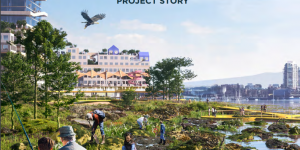As part of my involvement in the Sea2City Design Challenge, I worked on the False Creek Coastal Adaptation Plan, collaborating with CityStudio and the City of Vancouver to address the critical issue of sea level rise and its impact on the False Creek region. This project was particularly meaningful to me as a student of psychology and geography in the Coordinated Arts Program, as it allowed me to connect my academic background with real-world climate adaptation efforts.
During my participation, I visited Stamps Landing, a key site in the Coastal Adaptation Plan, and closely examined the design proposal by the team Mithun+One. I was struck by a significant gap in their plan: the unsheltered cyclists in the area were not accounted for. These individuals, who rely heavily on cycling as their primary means of transportation due to the high cost of travel in Vancouver, were overlooked in the housing and mobility plans. This issue became the focus of my project.
Drawing inspiration from my ASTU class reading on Jonen Garnet's History of the New World, I explored how the proposed design would affect unsheltered cyclists. Garnet’s quote about systemic marginalization and the impact of societal structures on the most vulnerable resonated deeply with me and guided my analysis. I recognized that the unsheltered cyclists, many of whom camp at Stamps Landing, face not only the challenges of homelessness but also mobility barriers, especially as sea levels rise. The proposed design reduced the cycling lane, which would further limit their already constrained mobility.
In my critique, I emphasized the lack of housing solutions for this vulnerable group and the absence of accommodations in the Sea2City design. With sea levels predicted to rise by up to one meter by 2100, the unsheltered cyclists at Stamps Landing will face even more challenges, from the loss of their living spaces to increased health risks from colder temperatures and flooding. I argued that these issues must be addressed within the broader climate adaptation strategy for False Creek, ensuring that vulnerable communities are included in the planning process.
Ultimately, my participation in this project deepened my understanding of how climate change, urban planning, and social equity intersect. I also came to appreciate the importance of community engagement and the need to consider all stakeholders in adaptation plans.

The Sea2City Design Challenge was a transformative learning experience, blending theoretical knowledge with practical application. It deepened my understanding of how climate change and urban development intersect, particularly in vulnerable communities like the unsheltered cyclists in False Creek. By critically engaging with the proposed design and offering solutions that included marginalized groups, I learned the importance of inclusive urban planning and the need to prioritize social equity in climate adaptation efforts.
This project also enhanced my research and analytical skills, as I critically assessed the design proposals, visited sites, and connected my personal experiences to the issue at hand. Engaging with diverse stakeholders, including City staff, Indigenous representatives, and design teams, helped me develop an interdisciplinary approach to problem-solving and strengthened my ability to communicate complex issues. Ultimately, this experience reinforced my commitment to addressing environmental and social challenges in an integrated way, shaping my future academic and professional goals.